Summary | Key concept | Science Story | Background Science | Activity | Curriculum links | Linked Activities
- Suggested Age Range: 10 – 11 years
- UK Primary Curriculum: Key Stage Two (upper)
- Suggested UK Year Group: Year 6
- UK Primary Curriculum Link: Light
- Science Subject: Eclipses
- Science Question: Why do we have eclipses? What happens during solar and lunar eclipses?
- Activity type: pairs
- Suggested linked stories: When Jaguars Ate the Moon; The Buried Moon; How Lunar Eclipse Saved the Life of Columbo
- Suggested Linked Story for younger children: Stealing the Sun; Setting Free the Sun; Shooting Down the Sun
Brief summary: Solar and lunar eclipses are fascinating events where the Sun or Moon appears to disappear, respectively. Their spectacular nature causes a lot of interest. This activity looks at what happens during each type of eclipse using a physical model that the students can build themselves and experiment with to explore how and why eclipses happen.
Key concept: light always travels in straight lines, and objects placed in the path of light result in shadows.
Key words: light, shadow, solar eclipse, lunar eclipse, reflection, simulation, modelling
Visuals:
- Solar eclipse seen from Rangpur, India, in 2009: download movie
- Lunar eclipse simulation: download movie
- Red Moon, as seen during a total lunar eclipse: download image
The Science Story:
Where does light come from during the day?
Light comes from the Sun. The Sun is a star, just like the stars we see at night, but it looks much bigger and brighter because it is much closer than the other stars. The Moon is not a star, it is made of rock, like the Earth, and it is much closer to us than the Sun.
Does the Moon shine?
The Moon is bright, but not as bright as the Sun, and it doesn’t shine like the Sun. We see the Moon because it reflects light from the Sun. That’s how I can see you right now – the light from the Sun bounces off your skin and is reflected back to my eyes. Light travels in straight lines, it cannot travel around a corner.
What happens if you hold out your hand in front of your face and cover the Sun with your thumb?
If you put your thumb between the Sun and your eye, you cannot see the Sun anymore because the light cannot travel around your thumb. This is how an eclipse happens, by something blocking light from the Sun.
How long does it take for the Earth to orbit the Sun?
The Earth orbits the Sun in one year. The Sun shines on the Earth, the side of the Earth nearest the Sun is lit up and has daytime, and the other side is dark and it is night. The Earth has a shadow, just like you do. In the shadow of the Earth it is also dark. The Moon goes around the Earth in about 29 days, and the Moon also has a shadow. Sometimes, when everything lines up just right, the Moon moves directly between the Sun and the Earth.
What do you think happens?
When everything lines up perfectly, the shadow of the Moon passes across the Earth. If you are lucky enough to be standing in the shadow of the Moon, you will see the Sun disappear behind the Moon – this is a solar eclipse (video).
What do you think happens when there is a lunar eclipse?
In a lunar eclipse, instead of the shadow of the Moon passing over the Earth, this time the Moon passes through the shadow of the Earth! The Earth is bigger than the Moon, so the Earth has a bigger shadow. A solar eclipse only lasts for a few minutes because it doesn’t take long for the Moon’s small shadow to move across the Earth. The Moon takes much longer to pass through the larger shadow of the Earth, so a lunar eclipse can last for several hours (video).
The Science: The Sun is a star and is the source of all the heat and light in the Solar System. Light from the Sun travels outwards in straight lines. The Earth orbits the Sun, completing one full orbit in a year. The Moon is our companion in the Solar System and orbits the Earth every 29.5 days. The Moon does not emit its own light, instead we see it because it reflects light from the Sun. Eclipses happen when these three objects line up precisely, the two different types of eclipse happen when we get particular alignments.
If the Moon lies between the Sun and the Earth, the shadow of the Moon passes across the face of the Earth and we see a solar eclipse (video). If the Moon passes through the shadow of the Earth, then we get a lunar eclipse (video). The example using your thumb, used above, works well as an analogy since your thumb is smaller than your head. The shadow of your thumb covers only a small part of your face (the students will appreciate this better if they watch each other try it), but the shadow of your head is many times wider than your thumb. If the Earth and Moon orbited in a precise plane, then we would get both types of eclipse every month as the Moon orbited the Earth. This is not the case, however. The Moon’s orbit is slightly tilted, such that the Sun, Earth and Moon only occasionally line up precisely.
While the Sun is eclipsed, the dark disk of the Moon appears surrounded by a bright halo. This halo is the outer layers of the Sun’s gas, known as the corona. An eclipse is the only time we can study this corona from the surface of the Earth because it is so faint compared to the full glare of the Sun that normally it cannot be seen against the bright sky. When the Moon is eclipsed and in the shadow of the Earth it gets much fainter and turns a deep red colour. This effect is due to scattering of light as it passes through the atmosphere of the Earth. It is the same effect that makes sunsets look red – blue light is scattered more than red light, so the longer the light has to travel through the Earth’s atmosphere, the more the blue light is scattered away, leaving only red light behind. This effect means that if you were standing on the surface of the Moon during a lunar eclipse the light that reached you would have had all the blue light scattered away. The result would look as if the Earth were surrounded by a sunset.
In the past, many cultures it was thought that a solar eclipse was a portent of doom or that they happened because the gods were displeased; some cultures made sacrifices to please the gods so that the Sun would return – the Aztecs are one example. Even today, many cultures still have superstitions surrounding eclipses of either type, and in some parts of the world people stay indoors to avoid evil spirits.
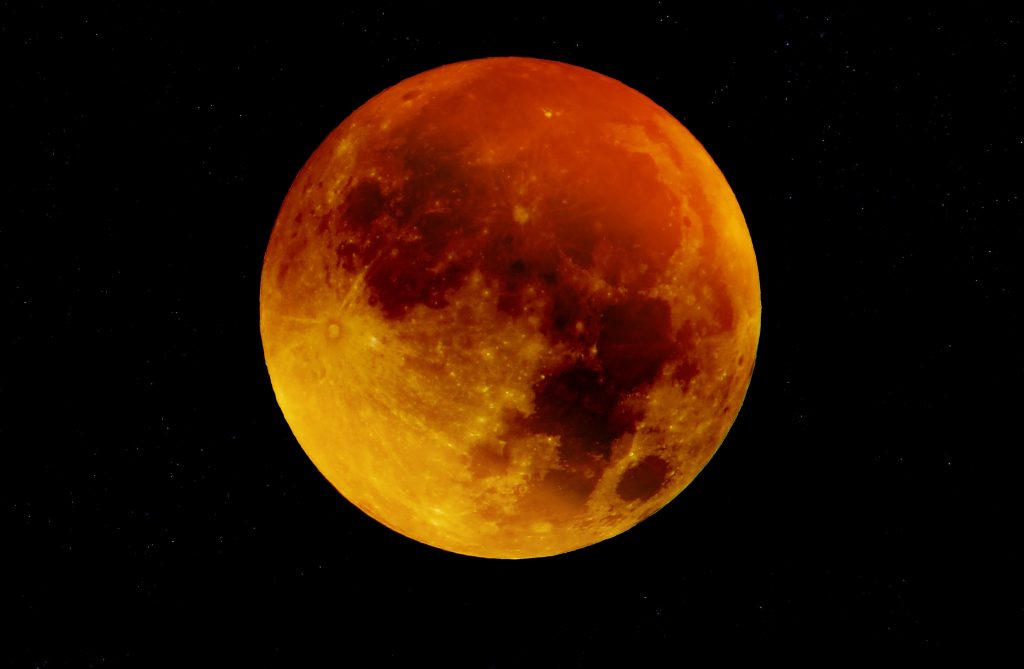
The activity: This activity uses some straightforward materials that can be obtained from pound shops and craft suppliers. The students work together in small groups to build their own model of the Sun-Earth-Moon system, and then use a lamp to investigate the shadows caused by the Earth and Moon and see how eclipses can happen.
Props required:
- Adhesive tape
- Two cardboard tubes (e.g. empty kitchen paper rolls or similar)
- Scissors (suitable for cutting cardboard)
- Small piece of aluminium foil
- Sturdy but bendable wire (35–50 cm long)
- Styrofoam ball (roughly the size of a large orange)
- Ping pong ball (or a Styrofoam ball of a similar size)
- Large strip of cardboard (about 50-60 cm long and 15-20 cm wide)
- Torch
Safety note: It must be stressed that you must NEVER look directly at the Sun as this can permanently damage your eyes. It is perfectly safe to look directly at the Moon.
Safety note: Care should be taken with scissors when cutting the tubes, and students should be supervised closely.
- For this activity you need to work together in small groups, so find two or three other people to work with.
- Take one cardboard tube and make a series of small (2-cm deep), even, vertical cuts around the circumference of each end. Bend the cut pieces out at each end and then stand the tube upright on the table. The cut edges should fan out like a flower.
- Using adhesive tape, fasten one end of the cardboard tube to the cardboard strip to create the base of the model. The tube should be close to one end of the cardboard strip.
- Using tape or glue, attach the larger of your two styrofoam balls to the top of the tube. This ball represents the Earth.
- Cover the smaller ball with aluminium foil, with the shiny side on the outside. This will be the Moon.
- Insert one end of the wire into the top of Earth so that the wire is vertical. Measure approximately a finger’s length along the wire and bend the wire here at a right angle, creating a horizontal arm.
- About halfway between the Earth and the far end of the cardboard strip, measure a finger’s length along the wire and bend it again. This time bend it downwards at a right angle, towards the cardboard base (see image gallery, blow).
- Insert the other end of the wire into the Moon. The Moon’s equator should be at the same height as the Earth’s equator.
- As in Step 2&3, make small cuts in the other cardboard tube and tape it to your cardboard strip at the opposite end to the Earth.
- Balance the torch on the second cardboard tube. Make sure the height is correct: the middle of the torch beam should hit Earth’s equator. Ensure that the beam directly hits the nearest half of the Earth and the Moon.
- Now we have created our model of the Earth-Sun-Moon system. Next we will use our model to explore what happens during different types of eclipse.
- Create a solar eclipse: Stand facing the torch and swing the wire around until the Moon casts a shadow on the Earth. If you can, dim the lights in the room so the light is easier to see. The Moon is now positioned between the Earth and the Sun and is blocking the “sunshine” for some people on Earth. Notice that only people directly in the shadow will see a complete eclipse of the Sun.
- Explore how the shadow moves by slowly rotating the wire to make the Moon move.
- Create a lunar eclipse: Stand facing the torch and swing the wire so that the Moon is behind the Earth. No light should be hitting the Moon: the Earth is between the Sun and the Moon, casting a shadow over the entire Moon. Notice that unlike during the solar eclipse, the entire “night” side of Earth can see the lunar eclipse.
- Carry on moving your Moon around the Earth to see how the light changes throughout a full orbit.
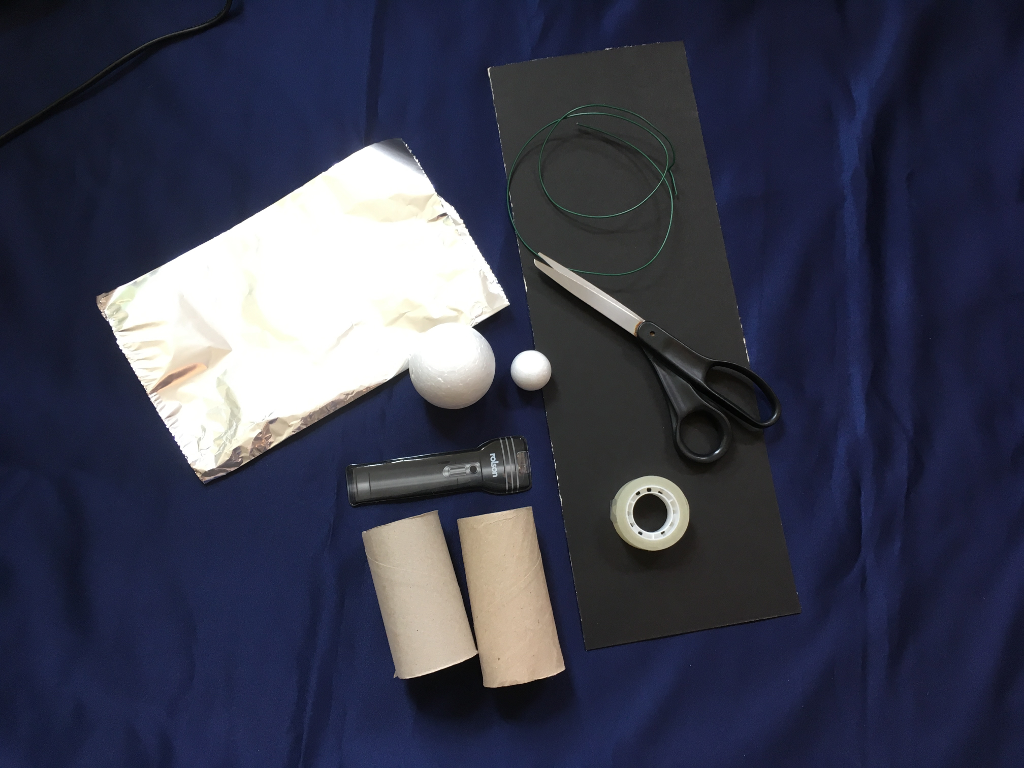
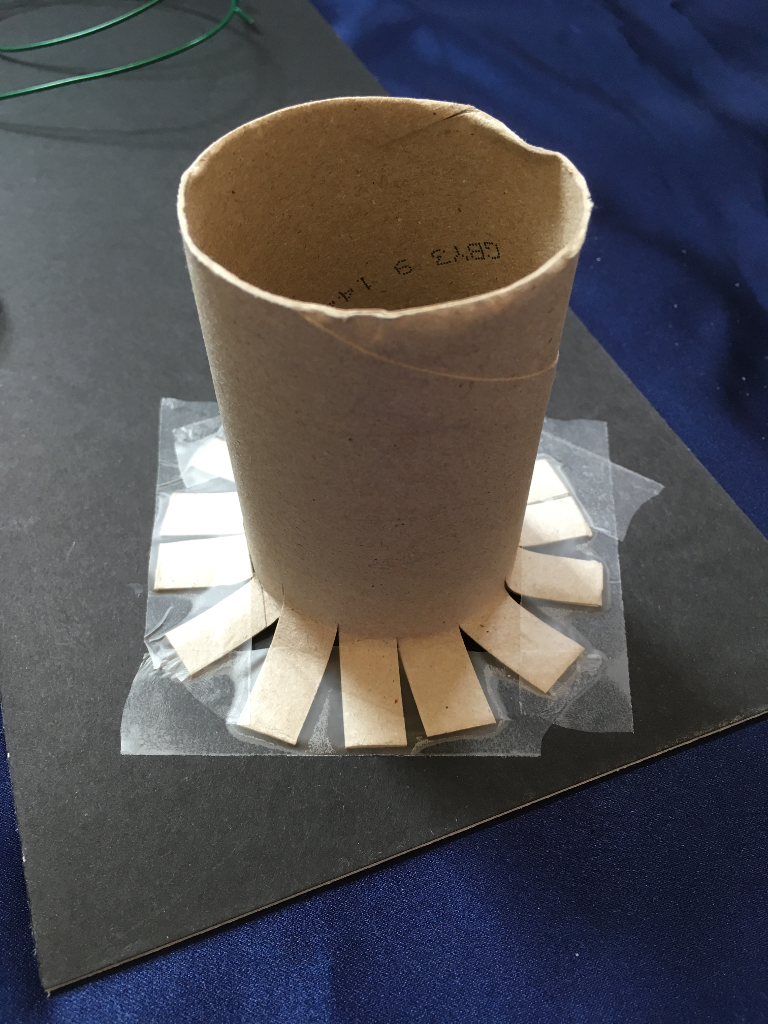
Steps 2&3: Tape down the cardboard tube. 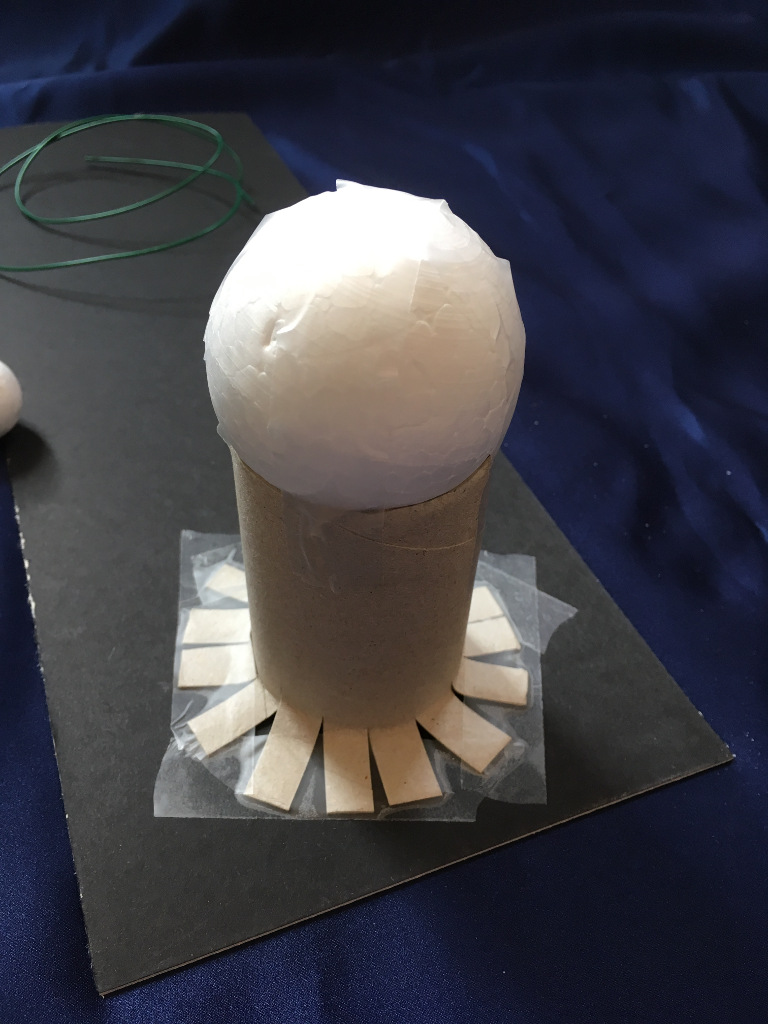
Step 4: Stick the larger ball to the tube – this is the Earth. 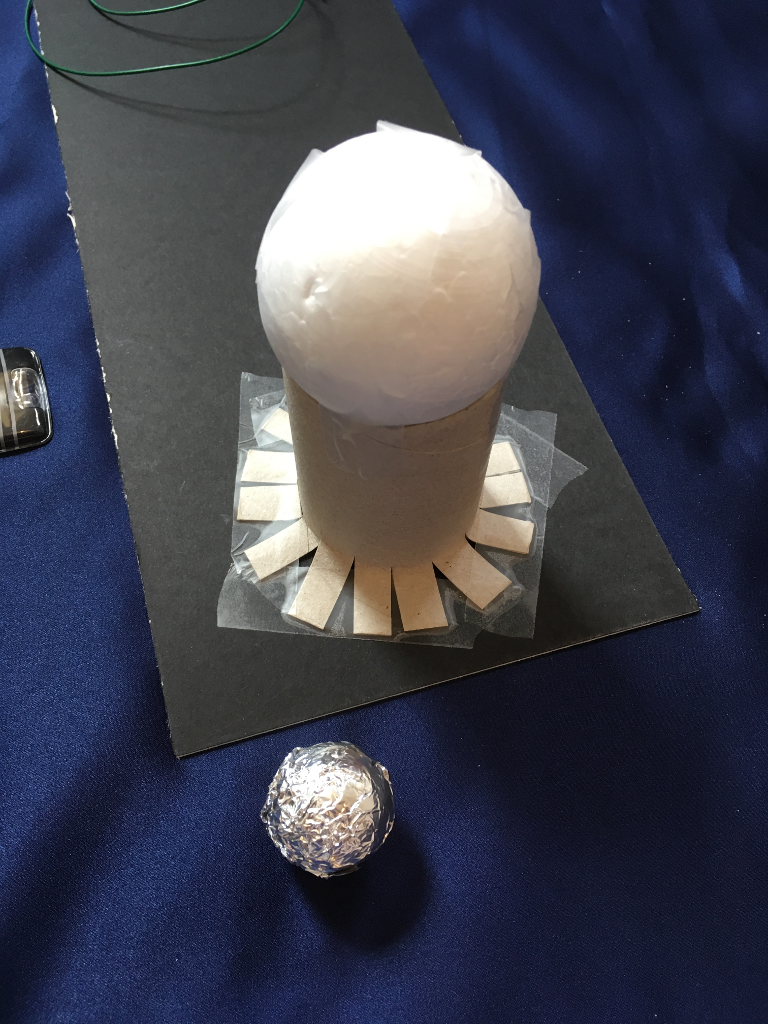
Step 5: Cover the smaller ball in foil – this is the Moon. 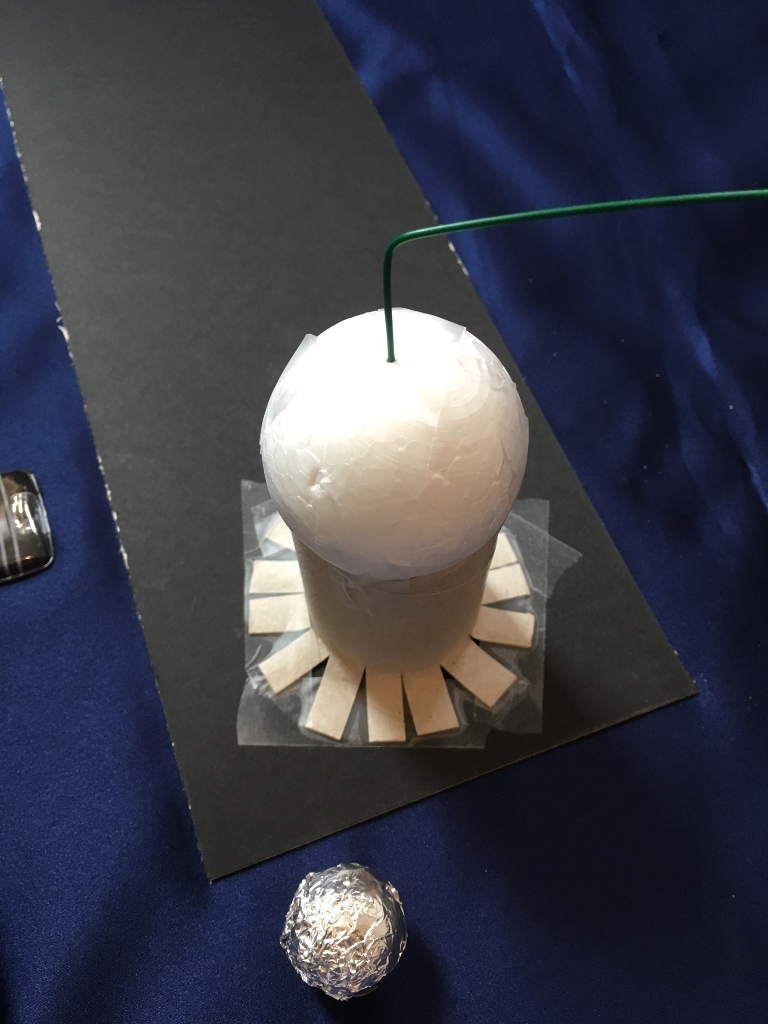
Step 6: Insert one end of the wire into the Earth ball and make a right-angle bend. 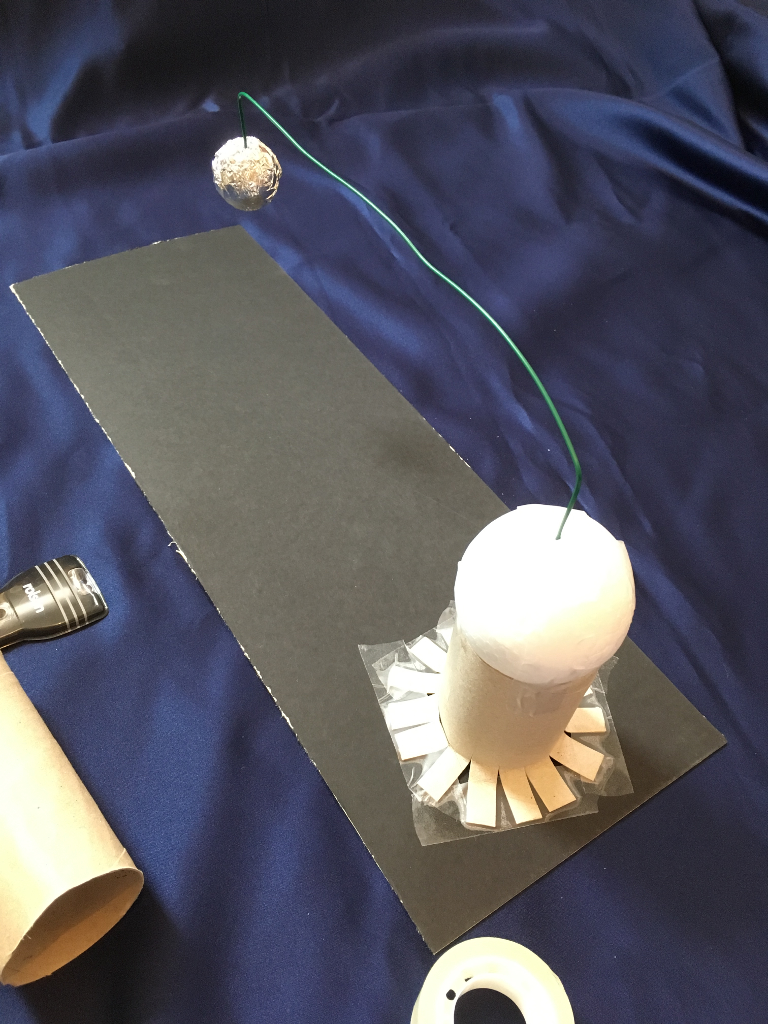
Steps 7&8: Insert the other end of the wire into the Moon ball. 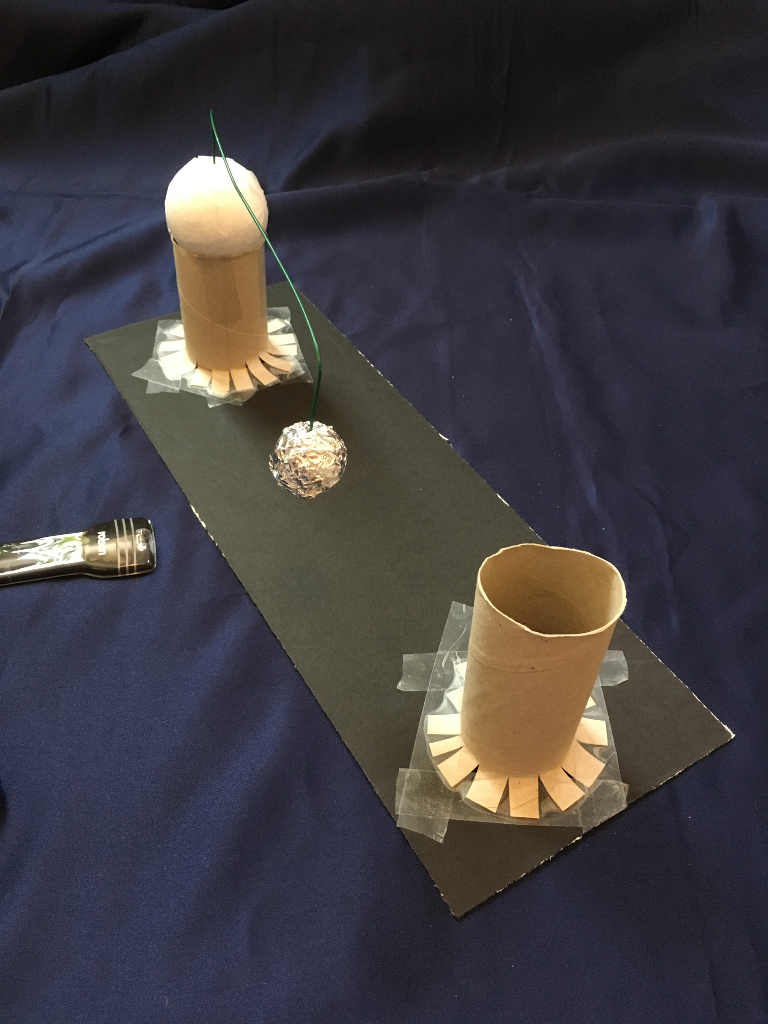
Step 9: Tape the other tube to the other end of your cardboard base. 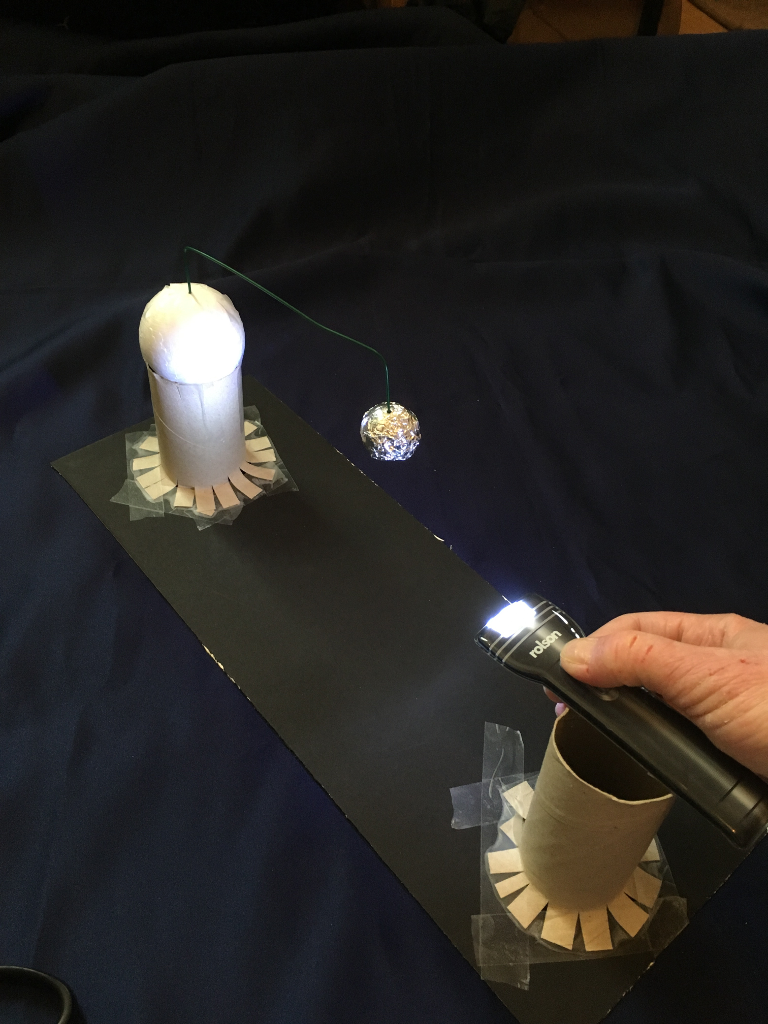
Step 10: Use your torch to shine light onto the Earth and Moon model – your torch acts like the Sun. 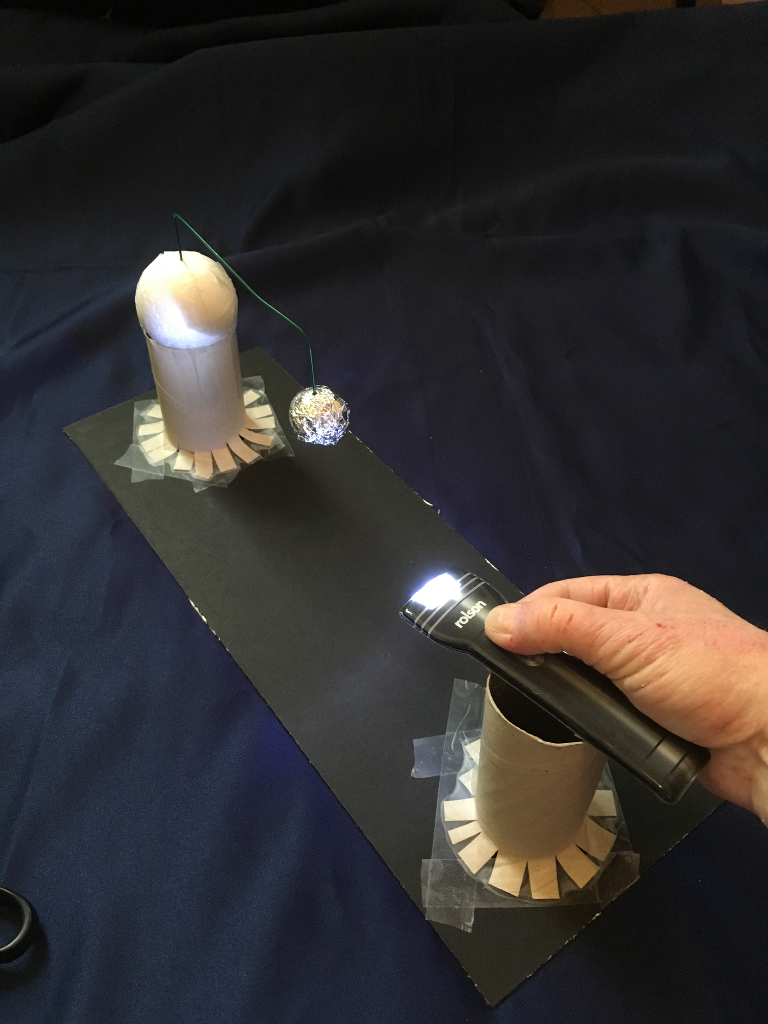
Step 12: When the Moon is between the Earth and the Sun, a shadow falls on the Earth and we see a solar eclipse. 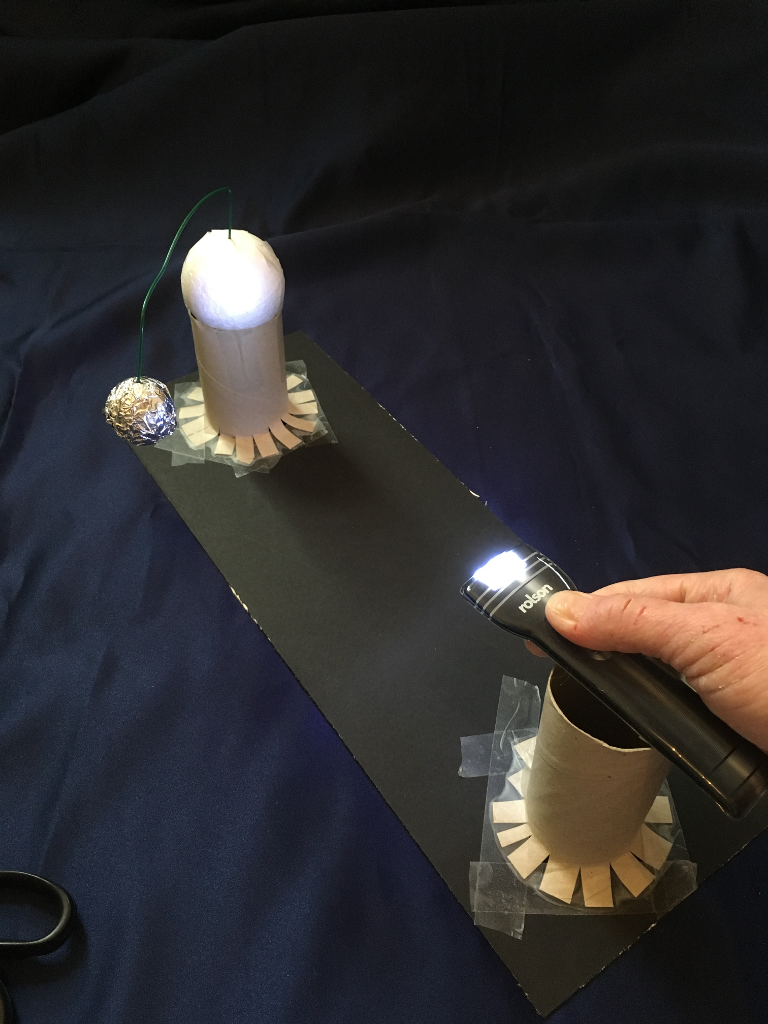
Step 13: When the Moon is elsewhere in its orbit around the Earth, no shadow crosses the Earth and no eclipse happens. 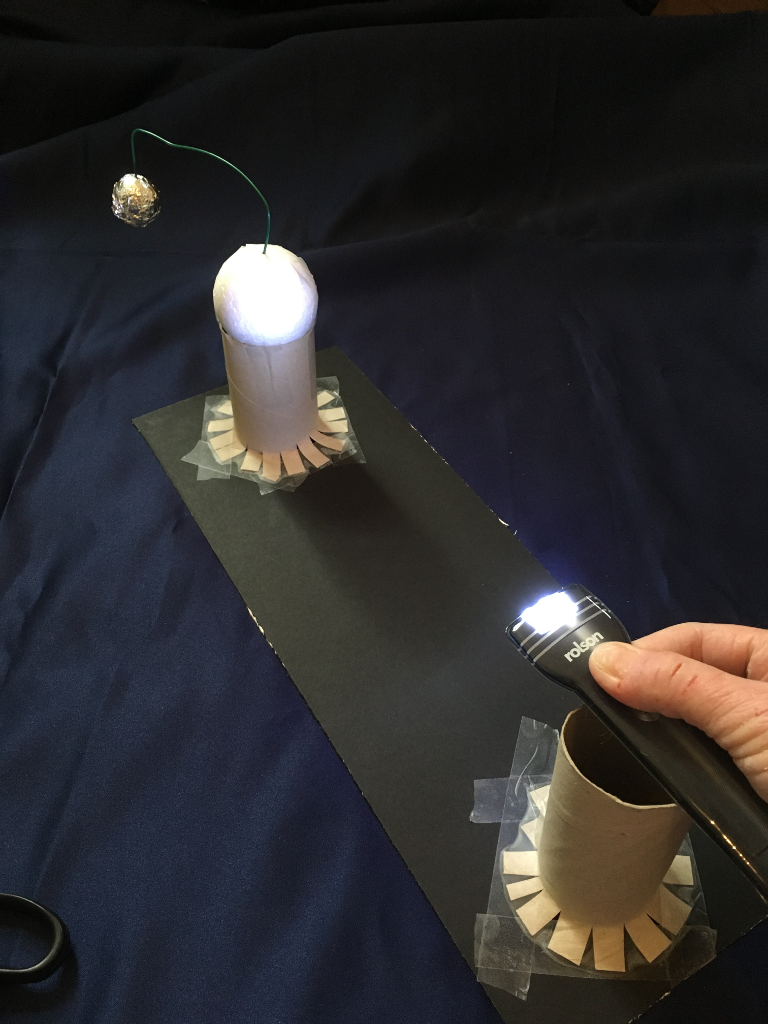
Step 14: When the Moon is on the opposite side of the Earth from the Sun, the Earth’s shadow falls on the Moon and we see a lunar eclipse. 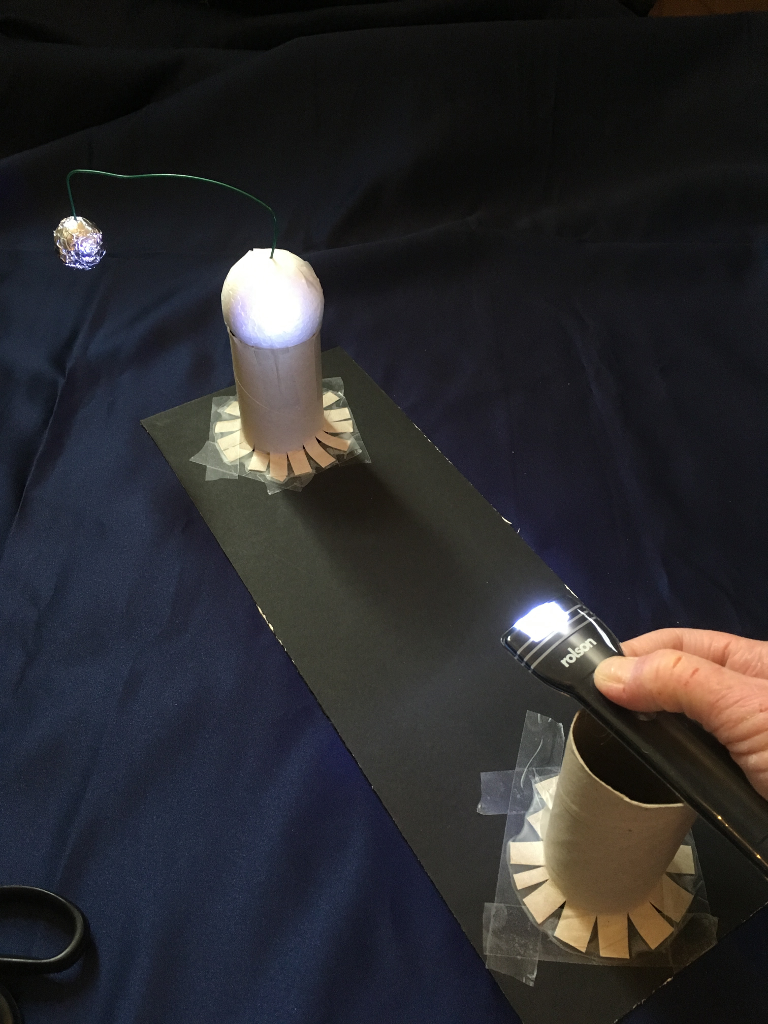
Step 15: Turn your Moon around the Earth and see how the phase of the Moon changes.
Extension: Challenge the students to explore the orbit of the Moon using their models. Ask them to describe what they see during each type of eclipse, depending on where they are located on the Earth, and what might an astronaut see if they were standing on the Moon? Further extending these ideas can lead to a discussion about what an eclipse looks like from the International Space Station, and whether eclipses can be seen on other planets.
Simulations of what both solar and lunar eclipses look like from various viewpoints can be found here: http://space.rice.edu/eclipse/eclipse_animations.html
Common misconceptions:
- Light bends around the Earth to cause the red colour during a total lunar eclipse – this is not true, since light always travels in straight lines. The red light that reaches the Moon has been scattered in the atmosphere of the Earth, much of the light is scattered in other directions, but some of it is scattered towards the Moon, we see this light reflected back from the Moon’s surface.
Curriculum links:
- Science KS2 Earth and Space – eclipses and the motion of objects in the Solar System
- Science KS2Working scientifically– there is plenty of scope in this activity for experimentation once the models have been made
- English KS1 and KS2 spoken language(extension activity) – communicate information effectively and at an appropriate level
Linked activities:
The Vanishing Sun, tales of solar and lunar eclipses produced by Cassandra Wye for NASA in 2017: https://www.lpi.usra.edu/education/explore/eclipse/
A range of eclipse activities produced by NASA: https://eclipse2017.nasa.gov/activities
Creating eclipses in the classroom, the source for this activity – Universe Awareness: https://www.unawe.org/activity/eu-unawe1302/
Linked resources:
Simulation of a solar eclipse seen from Rangpur, India, in 2009, made using Stellarium:
https://www.wesharethesamemoon.org/resources/activities/extras/SolarEclipseSimulation_Rangpur2009.mov
Simulation of a lunar eclipse, made using Stellarium:
https://www.wesharethesamemoon.org/resources/activities/extras/LunarEclipse.mov
Simulations of what both solar and lunar eclipses look like from various viewpoints, from Rice University:
http://space.rice.edu/eclipse/eclipse_animations.html
Copyright: Megan Argo 2019





